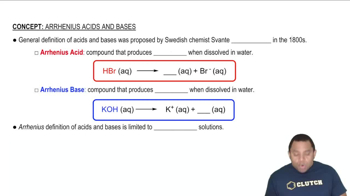Here are the essential concepts you must grasp in order to answer the question correctly.
Acid-Base Chemistry
Acid-base chemistry involves the study of substances that can donate protons (acids) or accept protons (bases). In this context, NH4Cl acts as an acid, providing NH4+ ions, while NH3 is a weak base. The interaction between these species is crucial for determining the pH of the solution.
Recommended video:
Arrhenius Acids and Bases
Henderson-Hasselbalch Equation
The Henderson-Hasselbalch equation is a formula used to calculate the pH of a buffer solution. It relates the pH to the pKa of the acid and the ratio of the concentrations of the conjugate base and acid. In this case, it helps to find the pH of the NH4+/NH3 buffer system formed by the dissolution of NH4Cl in NH3.
Recommended video:
Henderson-Hasselbalch Equation
Buffer Solutions
Buffer solutions are mixtures that resist changes in pH upon the addition of small amounts of acid or base. They typically consist of a weak acid and its conjugate base or a weak base and its conjugate acid. The NH4+/NH3 system acts as a buffer, allowing for the calculation of pH based on the concentrations of NH4+ and NH3.
Recommended video:
 Verified step by step guidance
Verified step by step guidance

